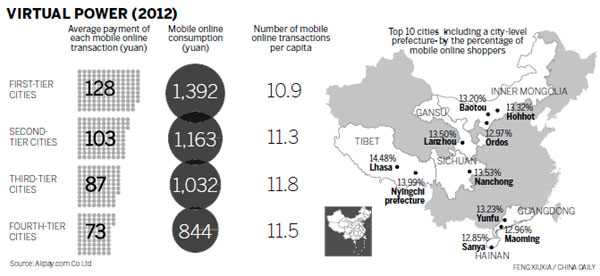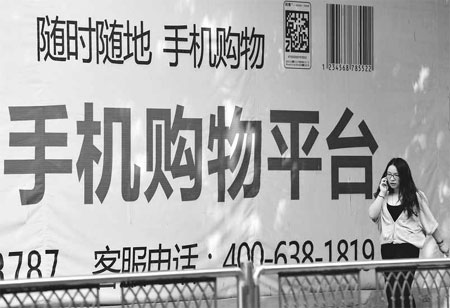Small cities make big strides
Updated: 2013-04-15 07:57
By Chen Limin (China Daily)
|
||||||||

|
An advertisement promoting an online smartphone store in Nanjing, capital of East China's Jiangsu province. Provided to China Daily |
Mobile online shopping gains more ground in lesser-known regions of China
Small cities in China have shown the fastest growing appetite for shopping through mobile devices, as is evident in the frequency they use mobile payment services, said a report.
Third- and fourth-tier cities - those at county level - occupied the entire top 10 list with the highest frequency of mobile payment usage, according to Alipay.com Co, China's biggest online payment company.
Lhasa, the capital city of the Southwest China's Tibet autonomous region, topped the list with 14.48 percent of Alipay users accessing the service via mobile devices. The list has a total of seven cities in western China, including Lhasa, which is less developed than the southern and eastern parts of China.
By contrast, Shanghai, the nation's economic center, had a mobile payment proportion of 8.44 percent last year, according to Alipay figures.
Alipay represented 46.9 percent of the online payment market in the third quarter of last year, according to domestic research company Analysys International.
"The gap between big cities and small ones is narrowing in terms of Internet coverage with the popularity of smartphones," said Zhan Yongsheng, manager of lifestyle services at Alipay, adding that smartphones are more popular and widely used than computers because the latter are more expansive.
"Paying telephone charges while taking a bus, buying a lottery ticket while walking These may probably be the most typical examples of mobile payment in small cities," he said.
Last year the number of people who used payment services through mobile devices more than tripled and the money they spent increased by 546 percent, according to Alipay figures. The number of transactions via mobile devices accounted for 9.2 percent of the total.
However, first-tier cities, such as Beijing, Shanghai and Guangzhou, remain strongest in the sheer size of mobile payment. People in these cities spent an average of 128 yuan on each payment via mobile devices, while those in third-tier cities spent 87 yuan, said Alipay.
Shopping and payment are among the most quickly expanding mobile services as an increasingly large number of people access the Internet through mobile devices.
Mobile Internet users accounted for 74.5 percent of China's total Internet population, which stood at 564 million by December, according to a report from the China Internet Network Information Center.
Taobao.com, China's biggest consumer-to-consumer online marketplace, said it had 300 million mobile users by the end of last year, which is close to the total population of the United States, compared with the 10 million mobile users it had in 2010.
On the whole, payment via both personal computers and mobile devices also found fourth-tier cities representing a strong force for development.
These cities saw the number of online payment users rise by 64 percent and their purchase amounts by 68 percent last year, both of which were higher than those in big cities, according to Alipay figures.
Gonjo county in the Tibet autonomous region stood out as the area with most rapid growth, with the number of online payments rising by 312 percent and the total amount by 718 percent, said Alipay.
However, big cities and economically advanced provinces remained top players in sheer size. Zhejiang province, where e-commerce giant Alibaba Group Holding Ltd is based, claimed nearly 15 percent of all online payments last year, followed by Guangdong province, Shanghai, Beijing and Jiangsu province.
chenlimin@chinadaily.com.cn

(China Daily 04/15/2013 page17)

 In Photos: 7.0-magnitude quake hits Sichuan
In Photos: 7.0-magnitude quake hits Sichuan
 Li Na on Time cover, makes influential 100 list
Li Na on Time cover, makes influential 100 list
 FBI releases photos of 2 Boston bombings suspects
FBI releases photos of 2 Boston bombings suspects
 World's wackiest hairstyles
World's wackiest hairstyles
 Sandstorms strike Northwest China
Sandstorms strike Northwest China
 Never-seen photos of Madonna on display
Never-seen photos of Madonna on display
 H7N9 outbreak linked to waterfowl migration
H7N9 outbreak linked to waterfowl migration
 Dozens feared dead in Texas plant blast
Dozens feared dead in Texas plant blast
Most Viewed
Editor's Picks

|

|

|

|

|

|
Today's Top News
Live report: 7.0-magnitude quake hits Sichuan, heavy casualties feared
Boston suspect cornered on boat
Cross-talk artist helps to spread the word
'Green' awareness levels drop in Beijing
Palace Museum spruces up
First couple on Time's list of most influential
H7N9 flu transmission studied
Trading channels 'need to broaden'
US Weekly

|

|








